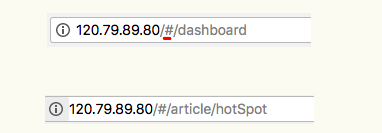vue |
您所在的位置:网站首页 › vue- router › vue |
vue
|
vue-router 的两种方式(浏览器环境下) 1. Hash (对应HashHistory) hash(“#”)符号的本来作用是加在URL中指示网页中的位置: http://www.example.com/index.html#print #符号本身以及它后面的字符称之为hash(也就是我之前为什么地址栏都会有一个‘#'),可通过window.location.hash属性读取。它具有如下特点: hash虽然出现在URL中,但不会被包括在HTTP请求中。它是用来指导浏览器动作的,对服务器端完全无用,因此,改变hash不会重新加载页面 2.可以为hash的改变添加监听事件: window.addEventListener("hashchange", funcRef, false)利用hash的以上特点,就可以来实现前端路由“更新视图但不重新请求页面”的功能了。每一次改变hash(window.lcation.hash),都会在浏览器的访问历史中增加一个记录 2. History (对应HTML5History) History接口 是浏览器历史记录栈提供的接口,通过back(), forward(), go()等方法,我们可以读取浏览器历史记录栈的信息,进行各种跳转操作。 从HTML5开始,History interface提供了两个新的方法:pushState(), replaceState()使得我们可以对浏览器历史记录栈进行修改: window.history.pushState(stateObject, title, URL) window.history.replaceState(stateObject, title, URL)这两个方法有个共同的特点:当调用他们修改浏览器历史记录栈后,虽然当前URL改变了,但浏览器不会刷新页面,这就为单页应用前端路由“更新视图但不重新请求页面”提供了基础。 浏览器历史记录可以看作一个「栈」。栈是一种后进先出的结构,可以把它想象成一摞盘子,用户每点开一个新网页,都会在上面加一个新盘子,叫「入栈」。用户每次点击「后退」按钮都会取走最上面的那个盘子,叫做「出栈」。而每次浏览器显示的自然是最顶端的盘子的内容。stateObject: 当浏览器跳转到新的状态时,将触发popState事件,该事件将携带这个stateObject参数的副本 title: 所添加记录的标题 URL: 所添加记录的URL vue-router 的作用 vue-router的作用就是通过改变URL,在不重新请求页面的情况下,更新页面视图。简单的说就是,虽然地址栏的地址改变了,但是并不是一个全新的页面,而是之前的页面某些部分进行了修改。 export default new Router({ // mode: 'history', //后端支持可开 routes: constantRouterMap })
这是Vue项目中常见的一段初始化vue-router的代码,之前没仔细研究过vue-router,不知道还有一个mode属性,后来看了相关文章后了解到,mode属性用来指定vue-router使用哪一种模式。在没有指定mode的值,则使用hash模式。 源码分析 constructor (options: RouterOptions = {}) { this.app = null this.apps = [] this.options = options this.beforeHooks = [] this.resolveHooks = [] this.afterHooks = [] this.matcher = createMatcher(options.routes || [], this) let mode = options.mode || 'hash' this.fallback = mode === 'history' && !supportsPushState && options.fallback !== false if (this.fallback) { mode = 'hash' } if (!inBrowser) { mode = 'abstract' } this.mode = mode switch (mode) { case 'history': this.history = new HTML5History(this, options.base) break case 'hash': this.history = new HashHistory(this, options.base, this.fallback) break case 'abstract': //非浏览器环境下 this.history = new AbstractHistory(this, options.base) break default: if (process.env.NODE_ENV !== 'production') { assert(false, `invalid mode: ${mode}`) } } }首先看一下vue-router的构造函数 case 'history': this.history = new HTML5History(this, options.base) break case 'hash': this.history = new HashHistory(this, options.base, this.fallback) break
主要是先获取mode的值,如果mode的值为 history 但是浏览器不支持 history 模式,那么就强制设置mode值为 hash 。如果支持则为 history 。接下来,根据mode的值,来选择vue-router使用哪种模式。 这样就有了两种模式。确定好了vue-router使用哪种模式后,就到了init。 先来看看router 的 init 方法就干了哪些事情,在 src/index.js 中 init (app: any /* Vue component instance */) { // .... const history = this.history if (history instanceof HTML5History) { history.transitionTo(history.getCurrentLocation()) } else if (history instanceof HashHistory) { const setupHashListener = () => { history.setupListeners() } history.transitionTo( history.getCurrentLocation(), setupHashListener, setupHashListener ) } history.listen(route => { this.apps.forEach((app) => { app._route = route }) }) } // .... // VueRouter类暴露的以下方法实际是调用具体history对象的方法 push (location: RawLocation, onComplete?: Function, onAbort?: Function) { this.history.push(location, onComplete, onAbort) } replace (location: RawLocation, onComplete?: Function, onAbort?: Function) { this.history.replace(location, onComplete, onAbort) } }
如果是HTML5History,则执行 history.transitionTo(history.getCurrentLocation())
如果是Hash模式,则执行 const setupHashListener = () => { history.setupListeners() } history.transitionTo( history.getCurrentLocation(), setupHashListener, setupHashListener )HashHistory.push()可以看出,两种模式都执行了transitionTo( )函数。 接下来看一下两种模式分别是怎么执行的,首先看一下Hash模式 我们来看HashHistory中的push()方法: push (location: RawLocation, onComplete?: Function, onAbort?: Function) { this.transitionTo(location, route => { pushHash(route.fullPath) onComplete && onComplete(route) }, onAbort) } function pushHash (path) { window.location.hash = path }window.location.hash = route.fullPath hash的改变会自动添加到浏览器的访问历史记录中。transitionTo()方法是父类中定义的是用来处理路由变化中的基础逻辑的,push()方法最主要的是对window的hash进行了直接赋值: 那么视图的更新是怎么实现的呢,我们来看父类History中transitionTo()方法的这么一段: transitionTo (location: RawLocation, onComplete?: Function, onAbort?: Function) { // 调用 match 得到匹配的 route 对象 const route = this.router.match(location, this.current) this.confirmTransition(route, () => { this.updateRoute(route) ... }) } updateRoute (route: Route) { this.cb && this.cb(route) } listen (cb: Function) { this.cb = cb }
可以看到,当路由变化时,调用了History中的this.cb方法,而this.cb方法是通过History.listen(cb)进行设置的。回到VueRouter类定义中,找到了在init()方法中对其进行了设置: init (app: any /* Vue component instance */) { this.apps.push(app) history.listen(route => { this.apps.forEach((app) => { app._route = route }) }) }
代码中的app指的是Vue的实例,._route本不是本身的组件中定义的内置属性,而是在Vue.use(Router)加载vue-router插件的时候,通过Vue.mixin()方法,全局注册一个混合,影响注册之后所有创建的每个 Vue 实例,该混合在beforeCreate钩子中通过Vue.util.defineReactive()定义了响应式的_route。所谓响应式属性,即当_route值改变时,会自动调用Vue实例的render()方法,更新视图。vm.render()是根据当前的 _route 的path,name等属性,来将路由对应的组件渲染到. 所以总结下来,从路由改变到视图的更新流程如下: this.$router.push(path) --> HashHistory.push() --> History.transitionTo() --> const route = this.router.match(location, this.current)会进行地址匹配,得到一个对应当前地址的route(路由信息对象) --> History.updateRoute(route) --> app._route=route (Vue实例的_route改变) 由于_route属性是采用vue的数据劫持,当_route的值改变时,会执行响应的render( ) -- > vm.render() 具体是在 中render --> window.location.hash = route.fullpath (浏览器地址栏显示新的路由的path)
HashHistory.replace() 说完了HashHistory.push(),该说HashHistory.replace()了。 replace (location: RawLocation, onComplete?: Function, onAbort?: Function) { this.transitionTo(location, route => { replaceHash(route.fullPath) onComplete && onComplete(route) }, onAbort) } function replaceHash (path) { const i = window.location.href.indexOf('#') window.location.replace( window.location.href.slice(0, i >= 0 ? i : 0) + '#' + path ) }
可以看出来,HashHistory.replace它与push()的实现结构上基本相似,不同点在于它不是直接对window.location.hash进行赋值,而是调用window.location.replace方法将路由进行替换。这样不会将新路由添加到浏览器访问历史的栈顶,而是替换掉当前的路由。 监听地址栏 可以看出来,上面的过程都是在代码内部进行路由的改变的,比如项目中常见的this.$router.push(), 等方法。然后将浏览器的地址栏置为新的hash值。那么如果直接在地址栏中输入URL从而改变路由呢,例如
我将dashboadr删除,然后置为article/hotSpot,然后回车,vue又是如何处理的呢? setupListeners () { window.addEventListener('hashchange', () => { if (!ensureSlash()) { return } this.transitionTo(getHash(), route => { replaceHash(route.fullPath) }) }) }
该方法设置监听了浏览器事件hashchange,调用的函数为replaceHash,即在浏览器地址栏中直接输入路由相当于代码调用了replace()方法.后面的步骤自然与HashHistory.replace()相同,一样实现页面渲染。 HTML5History HTML5History模式的vue-router 代码结构以及更新视图的逻辑与hash模式基本类似,和HashHistory的步骤基本一致,只是HashHistory的push和replace()变成了HTML5History.pushState()和HTML5History.replaceState() 在HTML5History中添加对修改浏览器地址栏URL的监听是直接在构造函数中执行的,对HTML5History的popstate 事件进行监听: constructor (router: Router, base: ?string) { window.addEventListener('popstate', e => { const current = this.current this.transitionTo(getLocation(this.base), route => { if (expectScroll) { handleScroll(router, route, current, true) } }) }) }
|
【本文地址】
今日新闻 |
推荐新闻 |
